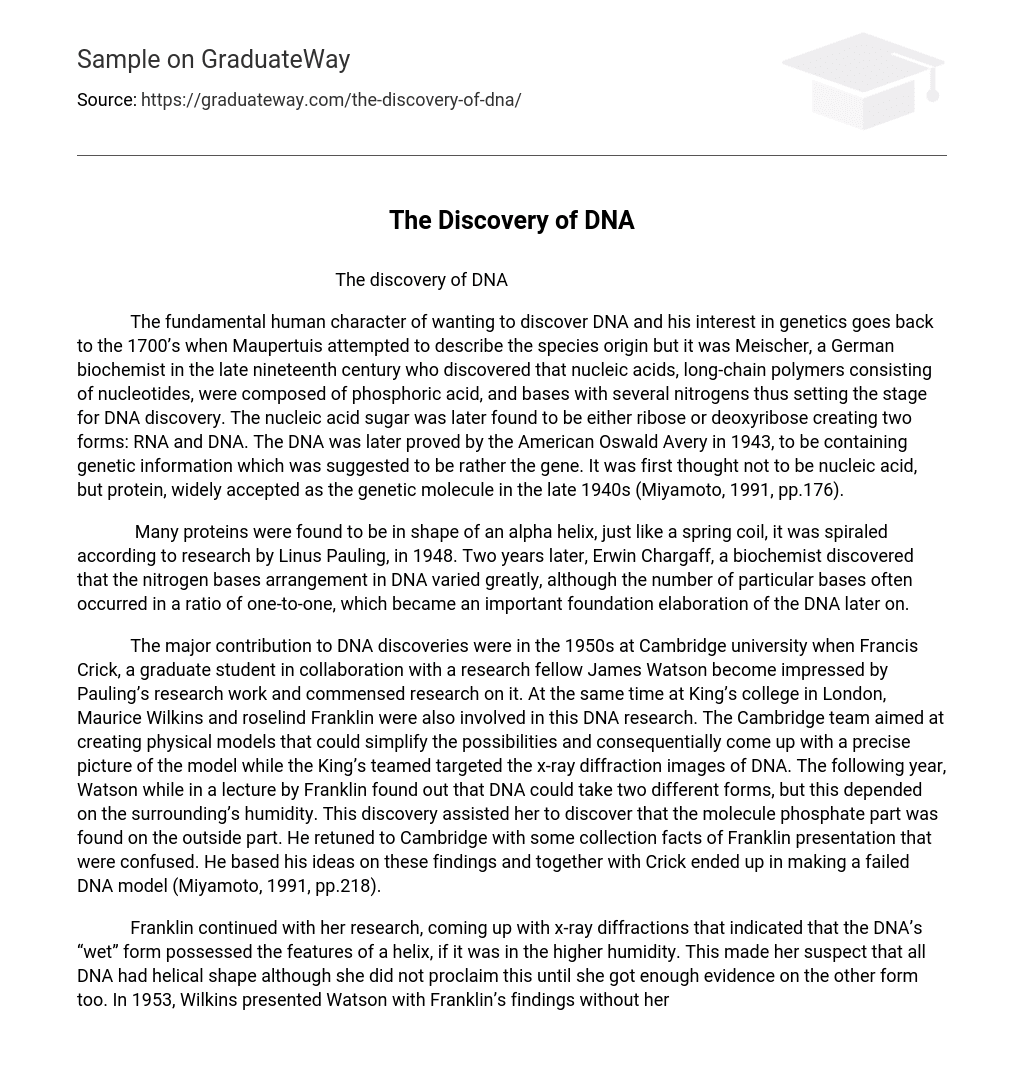The fundamental human character of wanting to discover DNA and his interest in genetics goes back to the 1700’s when Maupertuis attempted to describe the species origin but it was Meischer, a German biochemist in the late nineteenth century who discovered that nucleic acids, long-chain polymers consisting of nucleotides, were composed of phosphoric acid, and bases with several nitrogens thus setting the stage for DNA discovery. The nucleic acid sugar was later found to be either ribose or deoxyribose creating two forms: RNA and DNA. The DNA was later proved by the American Oswald Avery in 1943, to be containing genetic information which was suggested to be rather the gene. It was first thought not to be nucleic acid, but protein, widely accepted as the genetic molecule in the late 1940s (Miyamoto, 1991, pp.176).
Many proteins were found to be in shape of an alpha helix, just like a spring coil, it was spiraled according to research by Linus Pauling, in 1948. Two years later, Erwin Chargaff, a biochemist discovered that the nitrogen bases arrangement in DNA varied greatly, although the number of particular bases often occurred in a ratio of one-to-one, which became an important foundation elaboration of the DNA later on.
The major contribution to DNA discoveries were in the 1950s at Cambridge university when Francis Crick, a graduate student in collaboration with a research fellow James Watson become impressed by Pauling’s research work and commensed research on it. At the same time at King’s college in London, Maurice Wilkins and roselind Franklin were also involved in this DNA research. The Cambridge team aimed at creating physical models that could simplify the possibilities and consequentially come up with a precise picture of the model while the King’s teamed targeted the x-ray diffraction images of DNA. The following year, Watson while in a lecture by Franklin found out that DNA could take two different forms, but this depended on the surrounding’s humidity. This discovery assisted her to discover that the molecule phosphate part was found on the outside part. He retuned to Cambridge with some collection facts of Franklin presentation that were confused. He based his ideas on these findings and together with Crick ended up in making a failed DNA model (Miyamoto, 1991, pp.218).
Franklin continued with her research, coming up with x-ray diffractions that indicated that the DNA’s “wet” form possessed the features of a helix, if it was in the higher humidity. This made her suspect that all DNA had helical shape although she did not proclaim this until she got enough evidence on the other form too. In 1953, Wilkins presented Watson with Franklin’s findings without her consent, hence both of them took a critical step, coming up with the suggestion that the molecule had two chains of nucleotides, each chain having a helix form as in Franklin’s findings but added that one was going up while the other one down. Crick added Chargaff’s results about base pairs to the model, making matching base pairs seem to be interlocked in the double helix centre to maintain the chain constant distance (Tutton, 2004, pp. 79).
Watson and Crick elaborated that each DNA molecule strand was each others template. The two strands during division of the cell went apart creating a new “other” half strand. This indicated that DNA could reproduce itself but maintain its structure with exception of occasional errors. The DNA structure was precisely fitting the experimental data, thus was almost accepted immediately.
References:
Miyamoto M. Michael, 1991, Phylogenetic Analysis of DNA Sequences, Oxford, Oxford University Press, pp. 176, 218.
Tutton Richard, 2004, Donating and Exploiting DNA: Social and Ethical Aspects of Public Participation in Genetic Databases, London, Routledge, pp. 79.





